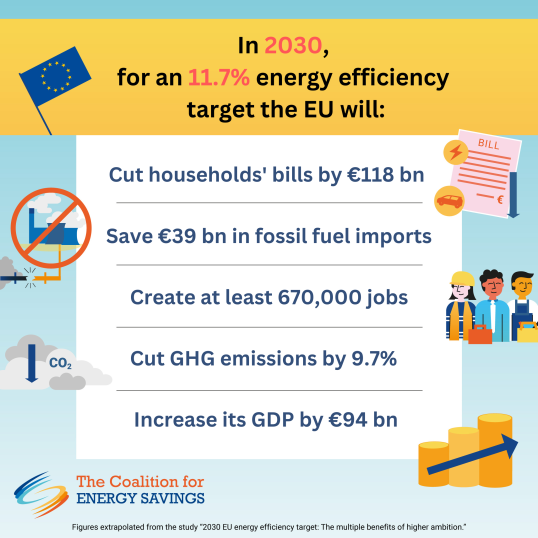
Energy savings and energy efficiency are at the heart of the European Union’s strategy to improve energy security, cut greenhouse gas emissions, and make the energy transition more affordable for citizens. With the political agreement on the recast of the Energy Efficiency Directive (EED) reached on the 10 March, the EU is one step closer to achieve those objectives. But there is no time for complacency, measures and investments to save energy must be accelerated immediately to both prepare for next winter and achieve the new, higher, EU 2030 energy efficiency target.
The ‘Fit for 55 package’ and the REPowerEU plan proposed to upgrade the current EED to align it with the higher 2030 climate objective and speed up the phase-out of fossil fuel imports from Russia. After almost two years of negotiations, the European Parliament, the Council of the EU and the European Commission agreed on a joint text that strengthens the existing energy efficiency framework, even if not to the level needed to grasp the energy savings potential and deliver its full benefits.
A MORE AMBITIOUS EU ENERGY EFFICIENCY TARGET FOR 2030
The new EED recast sets a higher target for 2030: the EU will have to cut its energy consumption by at least 11.7% compared to forecasts of energy use made in 2020. While this level of ambition is below the cost-effective energy savings potential (19%) and below what the Commission had deemed necessary in the REPowerEU plan to phase out fossil fuel imports from Russia (13%), it is still 9 percentage points higher than the current target.[1] When translated with measures on the ground, an 11.7% target would save 118 billion euros in energy and transport expenditures for the whole EU, equivalent to about 600 euros per household in 2030.
To signal that saving energy is not anymore a nice to have, the 2030 EU energy efficiency target, expressed in final energy, is made binding, a first for the EU energy efficiency framework. The mechanisms to ensure the EU target is met are also strengthened, for example with the requirement for Member States to implement additional measures if the Commission finds that countries are not on track to achieve their 2030 national objective.
STRONGER MEASURES TO DELIVER THE HIGHER TARGET
To underpin the higher 2030 target, many other EED provisions have been reinforced. The energy savings obligation, a pillar of the EED, is strengthened, with its annual end-use energy savings objective progressively rising from its current 0.8% to 1.9% as of 2028. The revised provision also becomes a crucial tool to make the energy transition more affordable for all citizens, requiring that a certain amount of energy savings is delivered among people affected by energy poverty, vulnerable customers and low-income households.
The public sector will also have to play a more prominent role in reducing its own energy consumption. First, the combined energy use of public bodies will have to decrease by 1.9% each year in every Member State. Second, 3% of the floor area of buildings owned by public bodies, including regional and local authorities, will have to be renovated each year to very low energy consumption levels (Nearly-Zero Energy Building or Zero-Emission Buildings levels). The EED recast also introduces a specific article on the application of the Energy Efficiency First principle, providing for the first time a legal basis for its streamlining in energy-related decisions and investments.
PLANNING AHEAD TO ACCELERATE ACTIONS
2030 is around the corner and the new EED will need to be implemented quickly and thoroughly to ensure energy efficiency measures are accelerated to the benefits of EU citizens. While Member States have two years from the EED entry into force to transpose the new provisions, they must already start planning as several key elements of the EED must be included in the draft update of the National Energy and Climate Plans (NECPs) due by 30 June 2023.
Member States must for example include in their draft update NECPs their revised higher national contributions to align with the new 11.7% energy efficiency target. Equally important, those national objectives should be clearly underpinned by policies and measures, with a clear timeline, envisaged to meet them. Similarly, information about how they plan to achieve the annual objective of the energy savings obligation must already be included in their draft plans.
NO TIME TO WASTE
In the last year, we have experienced the cost for society of not having exploited fully the cost-effective energy savings potential, leading to the urgent need to compensate weak efficiency policies with behavioural actions to save energy in a hurry and reduce imports. To give a long-term answer to high and volatile energy prices, address possible future supply shortages in a way that is climate compatible and socially fair, the implementation of the EED is the starting point to move beyond emergency measures and start putting in place structural solutions to save energy.
Recommended links:
About the author:
Arianna Vitali is Secretary General at the Coalition for Energy Savings since 2021. The Coalition strives to make energy efficiency and energy savings the first consideration of energy policies; it unites businesses, local authorities, energy agencies, energy communities and civil society organisations in pursuit of this goal. Before joining the Coalition, Arianna was Senior Policy Advisor at BPIE where she managed research projects and steered BPIE work related to the Renovation Wave. Previous to that, she was part of the climate and energy team of the WWF European Policy Office, where she coordinated WWF advocacy on energy savings in Europe.
[1] The 2018 EED sets an EU energy efficiency target of 32.5% for 2030 expressed as a cut in energy consumption compared to energy forecasts made in 2007; this corresponds to a cut in energy use of 2% when compared to the updated energy forecasts made in 2020.
Disclaimer: This article is a contribution from a partner. All rights reserved.
Neither the European Commission nor any person acting on behalf of the Commission is responsible for the use that might be made of the information in the article. The opinions expressed are those of the author(s) only and should not be considered as representative of the European Commission’s official position.
RELATED ARTICLES:
➔ Saving energy, the foundation of a more secure energy system
➔ From fringe to mainstream: the opportunities (and risks) of a thriving community energy movement
➔ Everyone has a part to play: citizen engagement and energy efficiency
Details
- Publication date
- 4 May 2023
- Author
- European Climate, Infrastructure and Environment Executive Agency

